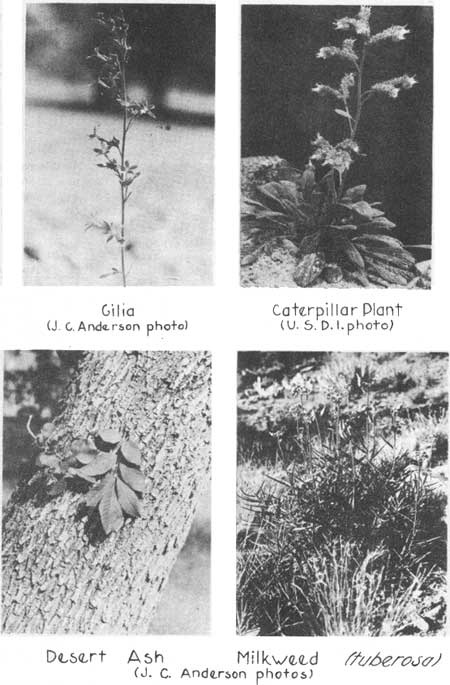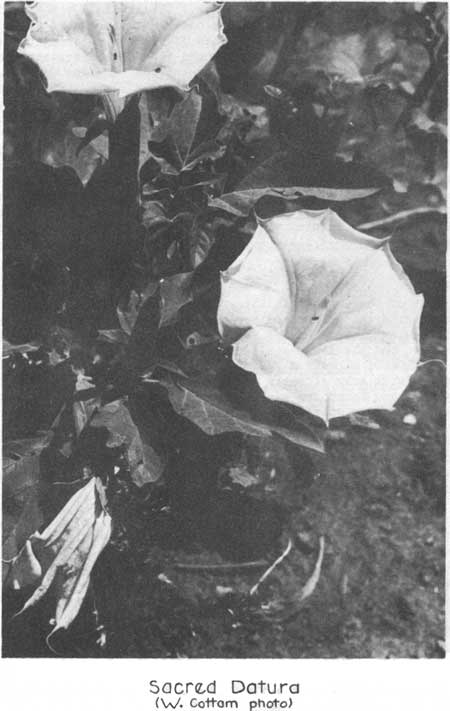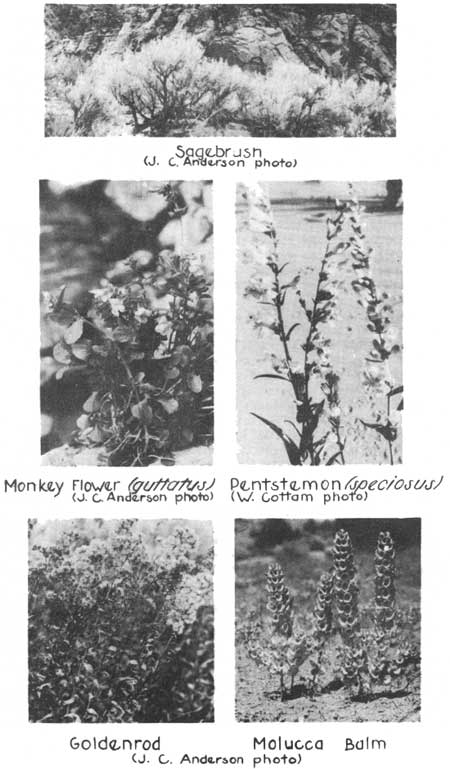|
ZION
Plants of Zion National Park |

|
Zion-Bryce Museum Bulletin
Number 1
PLANTS OF ZION NATIONAL PARK
Families of Plants
(continued)
PHLOX FAMILY (POLEMONIACEAE)
Many members of this family are found in Zion, and although most of them are small plants, they usually have showy flowers. The flowers have five petals and are often funnel-shaped with the petals forming a flat saucer or wheel at the end.
Four kinds of PHLOX occur here, all of them low, more or less mat-like plants having narrow opposite leaves without stems, (Plate VII). They may be distinguished as follows:
Leaves over 1 inch long, flowers white:
Phlox longifolia, leaves very narrow, threadlike.
Phlox stansburyi, leaves about 1/8 inch wide and shorter; plant a densely matted "pincushion".
Phlox douglasii, flowers white.
Phlox canescens, flowers pale purple.
The last two are the most common, growing in rocky places, usually above 5000 feet, as along the Mt. Carmel Highway.

PLATE XII
Collomia grandiflora is a tall, slender plant about 1-1/2 feet high, having narrow alternate stemless leaves and terminal clusters of showy cream-colored flowers, trumpet shaped. It is widely scattered over the park above 4000 feet altitude.
Langloisia matthewsii is a low diversely branching hairy plant with trident-shaped leaves and pale purple flowers; found chiefly in the Lower Sonoran Zone.
SCARLET BUGLER or SCARLET GILIA is one of the most showy of this family, easily recognized by the finely divided leaves near the base and the brilliant red trumpet shaped flowers scattered along the upper portion of the stalk (1 to 2 feet high). There are two varieties, looking almost exactly alike except for the length of the flowers: Gilia arizonica, (Plate XII) has flowers slightly less than one inch long, blooming in June, below 4000 feet; and Gilia aggregata, has flowers over 1 inch long, blooming from May to July on the plateaus. Other Gilias found in Zion are: Gilia frutescens, Gilia polycladon and Gilia micromeria, all small and inconspicuous.
Other small inconspicuous members of this family, characterized by diverse branches and fine hair-like leaves, are Navarretia intertexta, Welwitschia floccosa and Leptodactylon nuttallii. The first two have pale blue flowers, the last one, cream-colored flowers, and leaves in whorls.
WATERLEAF FAMILY (HYDROPHYLLACEAE)
The plants of this family have 5-petaled flowers, quite similar to those of the Gilia family. In all of our species the flowers are in small coiled spikes, somewhat resembling a fiddle neck.
CATERPILLAR PLANT, Phacelia heterophylla, is the most common of the family, growing throughout the park above 4000 feet, especially noticeable along the lower part of The Narrows Trail. The name refers to the hairy coiled flower clusters, with inconspicuous white flowers (Plate XII). Phacelia fremontii has more conspicuous flowers, blue with yellow centers; one of the earliest blooming flowers in the park, appearing in late March and April throughout both Sonoran Zones. Two purple flowered kinds, Phacelia crenulata (a tall plant), and Phacelia pulchella (very small) bloom in April in the Lower Sonoran Zone, as at Coalpits Wash.
YERBA SANTA or MOUNTAIN BALM, Eriodictyon angustifolium. This low leafy shrub is locally common along Oak Creek. It has narrow leaves, sticky and aromatic, smooth on the upper sides, white woolly on the lower. It has some value as a remedy for colds or sore throat.
Hydrophyllum watsoni and Tricardia watsoni have also been collected within the park.
BORAGE FAMILY (BORAGINACEAE)
Like the preceding family, this one is also characterized by 5-petal flowers, often in coiled "fiddle neck" spikes; it differs from the waterleaf family in that the seed pod is replaced by 4 seed-like nutlets. The common forget-me-not belongs to this family.
BLUEBELLS, Mertensia arizonica. (Plate IV). A tall, smooth perennial with small clusters of drooping delicate blue flowers, in May and June. North of the park, at higher elevations, it is very common, but inside our boundaries it is known only from a few wet places on Horse Pasture Plateau.
PUCCOON is a small plant with numerous upright stalks bearing narrow stemless leaves; both leaves and stems are very hairy. It has showy yellow trumpet-shaped flowers. There are three kinds here:
Lithospermum linearifolium and Lithospermum multiflorum have flowers one inch long or less; Lithospermum oblongum has flowers 1 to 2 inches long. All bloom from April to June throughout most of the park.
Somewhat similar but smaller yellow flowers are borne by the 3 species of Oreocarya: O. flava, O. pustulosa, and O. confertiflora. All of these resemble Puccoon in being very hairy, but differ from it in that the flowers are in clusters along the stem instead of chiefly terminal.
Several other Borages are found in the park, all of them very hairy and with inconspicuous flowers: Lappula occidentalis, Cryptanthe watsoni, Amsinckia menziesii, and Amsinckia rugosa.
VERBENA FAMILY (VERBENACEAE)
A small family represented in Zion by a weedy plant, VERVAIN, Verbena bracteosa, which has been collected at the east entrance.
POTATO FAMILY (SOLANACEAE)
Our representatives of this family are herbs or small shrubs with flowers in which the five petals are more or less united to form a broad funnel, as in the morning glory.
WOLFBERRY, Lycium pallidum. A sturdy, spiny shrub about two feet high with very crooked branches which, when large, are covered with smooth wine-colored bark. Leaves and flowers (March and April) are light green and appear surprisingly delicate for such a rugged desert shrub. The berries are bright red, looking like tiny egg plants the size of a large pea. They are relished by many animals, and are often eaten by children and Indians. A Lower Sonoran Zone species occasionally extending up into warmer parts of Zion Canyon.
Two kinds of GROUND CHERRIES occur in the park, widely scattered at all altitudes: Physalis hederaefolia, and Physalis fendleri. They are semi-prostrate plants bearing small fruits and in papery husks.
BLACK NIGHTSHADE, Solanum nigrum, is found widely scattered throughout Zion Canyon; and Solanum triflorum has been collected at all altitudes. Neither species is very common, however.

PLATE XIII
SACRED DATURA, Datura meteloides. (Plate XIII). A conspicuous plant with very large white flowers that open at might and wilt in bright sunlight. It is one of the few Zion plants that bloom during the hot summer. A single plant will sometimes have over 100 blooms at one time. In all parts of Zion Canyon its flowers can be seen every morning from early June until frost in September or October. Many different names are locally applied to it: Zion lily, moon lily, jimson weed, etc.
The plant is poisonous to eat, especially the seeds, and was used by several Indian tribes to induce stuper and dreams as a part of a widespread religious cult. Scopolamine is the chief alkaloid contained in the plant.
Two kinds of WILD TOBACCO are found in Coalpits Wash: Nicotiana attenuata and Nicotiana trigonophylla. They are erect hairy plants with long tubular white flowers; attenuata has much wider leaves than trigonophylla.
MINT FAMILY (MENTHACEAE)
Most of the plants in this family have aromatic leaves, and can be further distinguished by their square stems, opposite leaves and irregular flowers having two lips, the upper one either entire or 2-lobed and the lower one 3-lobed.
HOARHOUND, Marrubium vulgare. A coarse white woolly (almost velvety) mint only slightly aromatic, originally introduced from Europe and now found on waste land throughout much of the United States; in the west it is especially common on land that has been overgrazed by sheep. Occurs in Zion at east entrance, Oak Creek, and various other places where it persists from pioneer ranch operations. Another mint having little or no odor is DRAGON-HEAD, Moldavica parviflora, a weedy plant with small light blue flowers; distribution much the same as Hoarhound.
SELF-HEAL, Prunella vulgaris, is distinguished by its dense oblong heads of small purple flowers at the tops of slender stems about one foot high or less. The leaves are narrowly oblong, and toothed. It is widespread throughout all the North Temperate Zone, but in Zion is not common because of the scarcity of damp meadows suitable to it.
MOLUCCA-BALM, Moluccella leavis. (Plate XIV). A curious plant, native to Asia, escaped from cultivation in southern Utah. A small field of it occurs near the Petrified Forest.
PURPLE SAGE, Salvia carnosa. A small shrub about 1 foot high with small gray-green broadly oval leaves and clusters of bright purple flowers at intervals along stems that rise above the foliage. It blooms in May and early June; common in both Sonoran Zones in Zion and throughout much of the southwest — "The Land of the Purple Sage".
MOCK PENNYROYAL, Hedeoma diffusa, is a slender "weed" with many upright branches; the leaves and purple flowers are very small. It has been collected on the Narrows Trail.
WESTERN PENNYROYAL, Madronella parviflora. A slender mint with small narrowly-oval leaves and a large round cluster of light purple flowers at the top of each stalk. Common on the plateaus and in all cool canyons. This mint has a very strong, pleasant odor, often noticed when riding or hiking along the trails.
MINT, Mentha penardi. A tall purple flowered mint with toothed leaves; found in a few wet places in Zion Canyon.
FIGWORT FAMILY (SCROPHULARIACEAE)
Many of the most showy flowers in the park belong to this large family, which is characterized by irregular flowers, much like those of the mint family. Figworts, however, do not have square stems, as do the mints. Snapdragons and foxgloves are familiar cultivated members of this family.
MULLEIN, Verbascum thapsus. A common plant on waste land, especially that which has been overgrazed. It is quite different than any other Zion plant, consisting of a single straight stalk, often 6 feet high, rising from a basal rosette of large oval leaves. The entire plant is covered with velvety hairs, giving it a gray-green appearance. Flowers are small and yellow.
Collinsia tenella, is widely scattered throughout the park at all altitudes, in shady places. It is an inconspicuous plant with opposite loaves and small blue flowers.

PLATE XIV
PENTSTEMONS, sometimes called "wild snapdragons" are among the most beautiful and conspicuous flowers in the park. They are easily recognized, being tall spikes (one a dwarf) of brightly colored snapdragon-like flowers; leaves opposite. (Plate XIV). Twelve kinds are at present known from within the park; they may be identified by the following key:
Flowers pale lavender, very large: PALMER'S PENTSTEMON, Pentstemon palmeri. The largest and most common pentstemon in the park, growing along all the highways and trails below 6000 feet, especially on freshly disturbed soil. The leaves are gray-green, and each pair is joined at the base, creating the impression that it is one leaf with the stem growing through the center. Blooms in late May and June. Another pale lavender form, Pentstemon platyphyllus, has been collected at east entrance. It differs from palmeri chiefly in the leaves, which are lance-shaped, and not joined at the bases. The flowers are slightly smaller.
Flowers blue; plant a dwarf, semi-prostrate: Pentstemon abietinus. Very common on the plateaus. The leaves are small and awl-shaped; the flowers shade to white at the base. Blooms in June.
Flowers blue; not slender; plant tall. Pentstemon speciosus: (Plate XIV) leaves over 1/2 inch wide, flowers sometimes shading to purplish or even red. A profuse bloomer (early June) and vary common throughout the park above 4500 feet; almost as common as Palmer's pentstemon. Pentstemon comarrhenus: leaves narrow, usually less than 1/4 inch wide. Flowers always blue (early June). Occupies the same range as speciosus, but is less common.
Flowers blue, distinctly slender; plant tall. Pentstemon pachyphyllus: stem and leaves smooth. Pentstemon humilis: stem and leaves slightly hairy, the latter toothed, flowers blue at outer ends only, remainder white. Both of these species bloom in May or early June; and are widely scattered throughout the park above 4000 feet.
Flowers red (or reddish-orange), leaves wide. Pentstemon bridgesii: flowers noticeably 2-lipped, the lower lip turned back, Pentstemon eatoni: flowers not so noticeably 2-lipped, lower lip not turned back. Both these species are widely scattered over the park above 4000 feet. A subspecies of eatoni, P. eatoni undosus slightly hairy on stems and leaves, is found at lower altitudes, from Coalpits Wash up to 5000 feet.
Flowers red, leaves narrow. Pentstemon torreyi: flowers noticeably 2-lipped, basal leaves oval; commonly found above 5500 feet. Pentstemon utahensis: flowers not noticeably 2-lipped, basal leaves linear; commonly found below 5500 feet.
The MONKEY FLOWERS, or MIMULUS, have blossoms quite similar to those of the pentstemons, and even more closely resembling those of a snapdragon, but they do not grow on tall spikes, the plants being more branching and leafy (leaves opposite).
Mimulus cardinalis, This is one of the most beautiful flowering plants along the Narrows Trail, or in cool damp places elsewhere; its large orange-red flowers and deep green leaves combine to produce a rich lush appearance. It is the largest mimulus in the park — flowers 1 to 2 inches long, and wide toothed leaves 3 to 5 inches long. Growing as it does in deeply shaded and well watered places, plants in bloom can be found during most of the summer.
Mimulus guttatus is a large yellow-flowered kind, (Plate XIV). It grows in the same cool moist habitats as does cardinalis, but seldom blooms later than mid-June. Both flowers and leaves are slightly smaller than in the preceding species.
In Coalpits Wash and Petrified Forest there is a small annual mimulus, Mimulus parryi, which occurs in 2 forms — yellow-flowered and purple-flowered. It blooms profusely in late April and May; often a single plant 5 inches high or less will have a half dozen flowers at once, each nearly an inch long. The purple-flowered form is the most common. Mimulus floribundus has also been collected in Coalpits Wash; it is a small plant with tiny flowers.
SPEEDWELL, Veronica americana, is a weedy trailing plant found in springs on the plateaus; the flowers are very small.
INDIAN PAINTBRUSH, Castilleja angustifolia. From late March until early May the warner hillsides below 6000 feet are beautified with clumps of deep red flowers which cannot be more aptly described then to say they are paintbrushes. They are by far the most conspicuous early spring flowers in Zion, especially noticeable on the slopes along Oak Creek and near south entrance. Four other kinds of Paintbrush are found in the park: Castilleja linariaefolia and C. linoides have narrow, almost hair-like leaves, and red flowers with yellow centers (the petals are yellow and the surrounding leaf-like bracts are red); they are usually found below 6000 feet. Castilleja confusa is a tall red kind, found on the plateaus. Castilleja flava has yellow flowers; it is usually found in sagebrush above 6000 feet.
ELEPHANT HEADS, Pedicularis centrenthera. This peculiar plant is found in the few wet places that there are on Horse Pasture Plateau. It is a very low plant, almost stemless, consisting of a rosette of pinnately compound leaves from the center of which rises a short stalk covered with small purple flowers, each one somewhat resembling the trunk and tusks of an elephant.
Two other members of this family, Adenostegia capitata, and Orthocarpus luteus, have been collected within the park.